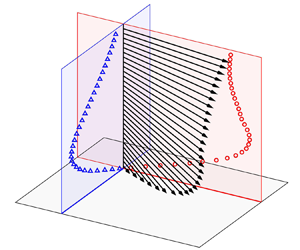Article contents
Three-dimensional properties of the viscous boundary layer in turbulent Rayleigh–Bénard convection
Published online by Cambridge University Press: 22 August 2022
Abstract

We report an experimental study of the viscous boundary layer (BL) properties of turbulent Rayleigh–Bénard convection in a cylindrical cell. The velocity profile with all three components was measured from the centre of the bottom plate by an integrated home-made particle image velocimetry system. The Rayleigh number  $Ra$ varied in the range
$Ra$ varied in the range  $1.82 \times 10^8 \le Ra \le 5.26 \times 10^9$ and the Prandtl number
$1.82 \times 10^8 \le Ra \le 5.26 \times 10^9$ and the Prandtl number  $Pr$ was fixed at
$Pr$ was fixed at  $Pr = 4.34$. The probability density function of the wall-shear stress indicates that using the velocity component in the mean large-scale circulation (LSC) plane alone may not be sufficient to characterise the viscous BL. Based on a dynamic wall-shear frame, we propose a method to reconstruct the measured full velocity profile which eliminates the effects of complex dynamics of the LSC. Various BL properties including the eddy viscosity are then obtained and analysed. It is found that, in the dynamic wall-shear frame, the eddy viscosity profiles along the centre line of the convection cell at different
$Pr = 4.34$. The probability density function of the wall-shear stress indicates that using the velocity component in the mean large-scale circulation (LSC) plane alone may not be sufficient to characterise the viscous BL. Based on a dynamic wall-shear frame, we propose a method to reconstruct the measured full velocity profile which eliminates the effects of complex dynamics of the LSC. Various BL properties including the eddy viscosity are then obtained and analysed. It is found that, in the dynamic wall-shear frame, the eddy viscosity profiles along the centre line of the convection cell at different  $Ra$ all collapse on a single master curve described by
$Ra$ all collapse on a single master curve described by  $\nu _t^d / \nu = 0.81 (z / \delta _u^d) ^{3.10 \pm 0.05}$. The Rayleigh number dependencies of several BL quantities are also determined in the dynamic frame, including the BL thickness
$\nu _t^d / \nu = 0.81 (z / \delta _u^d) ^{3.10 \pm 0.05}$. The Rayleigh number dependencies of several BL quantities are also determined in the dynamic frame, including the BL thickness  $\delta _u^d$ (
$\delta _u^d$ ( ${\sim } Ra^{-0.21}$), the Reynolds number
${\sim } Ra^{-0.21}$), the Reynolds number  $Re^d$ (
$Re^d$ ( ${\sim }Ra^{-0.46}$) and the shear Reynolds number
${\sim }Ra^{-0.46}$) and the shear Reynolds number  $Re_s^d$ (
$Re_s^d$ ( ${\sim } Ra^{0.24}$). Within the experimental uncertainty, these scaling exponents are the same as those obtained in the static laboratory frame. Finally, with the measured full velocity profile, we obtain the energy dissipation rate at the centre of the bottom plate
${\sim } Ra^{0.24}$). Within the experimental uncertainty, these scaling exponents are the same as those obtained in the static laboratory frame. Finally, with the measured full velocity profile, we obtain the energy dissipation rate at the centre of the bottom plate  $\varepsilon _{w}$, which is found to follow
$\varepsilon _{w}$, which is found to follow  $\langle \varepsilon _{w} \rangle _t \sim Ra^{1.25}$.
$\langle \varepsilon _{w} \rangle _t \sim Ra^{1.25}$.
JFM classification
Information
- Type
- JFM Papers
- Information
- Copyright
- © The Author(s), 2022. Published by Cambridge University Press
References
REFERENCES
- 2
- Cited by


